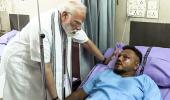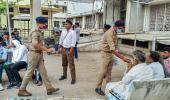'There may be 100 per cent burns on the bodies, but the bones, teeth, enamel are very resistant to only that much heat.'
"It was not a blast event. It was basically an airplane crashing on a building," Dr Rajesh Chandrakant Dere tells Vaihayasi Pande Daniel/Rediff.
- PREVIOUS: When DNA Falls Short...

The main difficulty will be for bodies that were completely burnt. And that may not be that difficult if you find a metal part.
It was not a blast event. It was basically an airplane crashing on a building.
But it was a fireball. And a lot of petrol. There would have still been a lot of heat?
Heat burns are different.
From the heat created from that site you cannot have 100 per cent combusted bodies.
Let me understand that again. You are saying from that kind of heat that AI 171 generated, when it crashed into the medical college mess, you won't have completely combusted bodies?
No, no, no, no, no. There may be 100 per cent burns on the bodies, but the bones, teeth, enamel are very resistant to only that much heat.

The heat of a blast is worse?
Yes, a blast means there is an explosion, like in a bomb blast. Because of explosives more heat is created. This is a dash -- an airplane hitting on a harder surface.
Because of the fuel of the airplane, there were flames, undoubtedly. But I have not read, and I have not seen in any video or photograph, that the bodies have been 100 per cent burnt.
We may get 100 per cent charred bodies. Charring is a different thing (and there will still be remnants). And complete combustion of a body is a different phenomenon.
- NEXT: 'DNA Tests Take Time'
Feature Presentation: Ashish Narsale/Rediff










